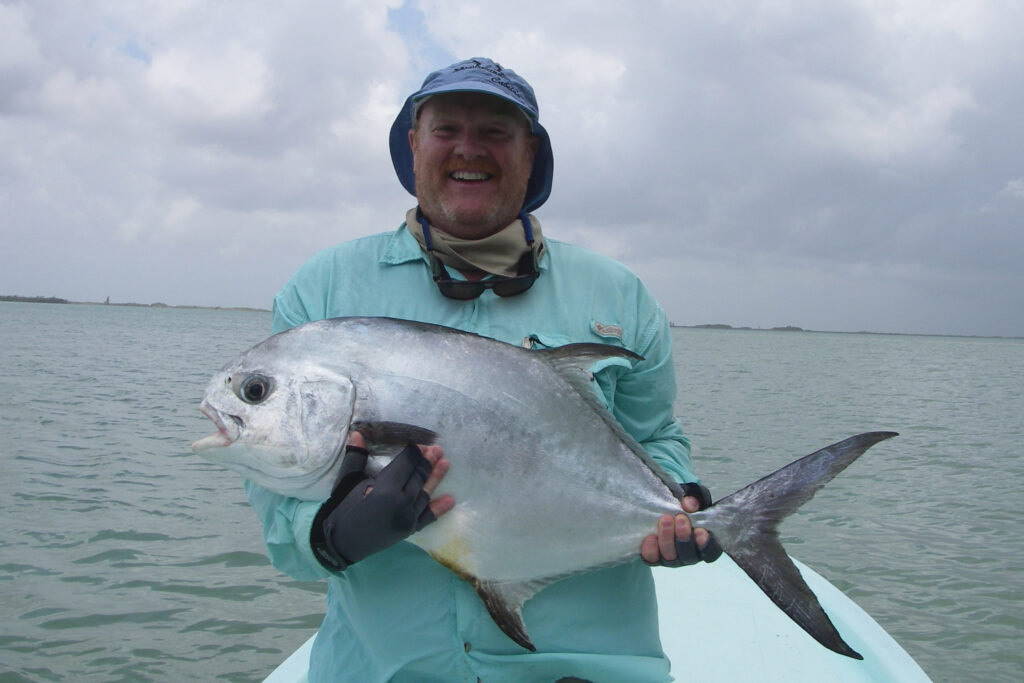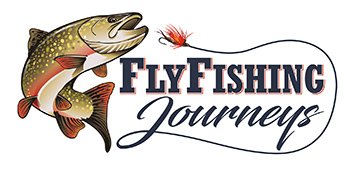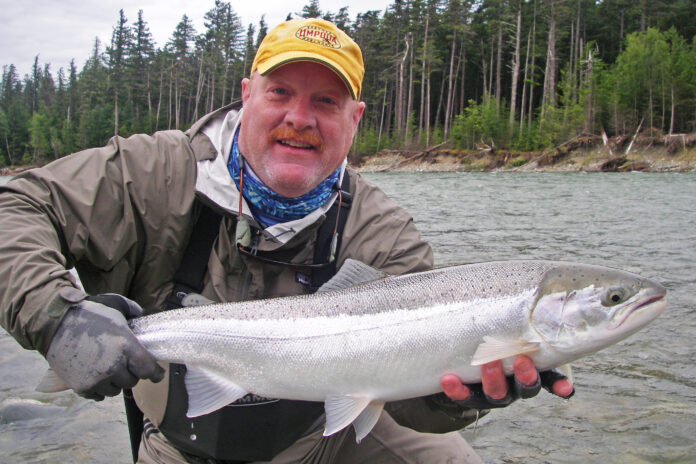Fly tying is more than just a hobby for Al Ritt—it’s a lifelong passion that has shaped his journey as an angler, instructor, and fly designer. From crafting makeshift flies as a child to designing patterns used by anglers worldwide, Ritt shares insights into his evolution in the sport, the philosophy behind fly design, and the importance of technique over rigid pattern adherence.
In this in-depth conversation, he discusses his favorite materials, tools, and mentors while offering invaluable advice for beginners and seasoned tiers alike. Whether he’s tying for personal use, teaching a class, or preparing for a presentation, Ritt’s dedication to the craft shines through every aspect of his work.
Fly tying has been around for a while. When were your interests peaked?
This is a difficult question, I can’t really pinpoint a genesis. I remember badgering my parents for a fly tying kit as early as 4th or 5th grade, even though I didn’t fly fish or k now anything about tying. I was making “flies” at that time by forming my own “hooks” from the wire closures used on bread packages and adding pipe cleaners for bodies and shaping them for wings. I finally did get a kit and my Grandmother helped me some (Lyle Dickerson; a neighbor, noted bamboo rodmaker and fishing partner of my Grandfather has set her up to tie fly orders for some fly shops during WWII) and I do remember I caught my first trout ever (a small brook trout) on the first fly she helped me tie.
But growing up in SE Michigan I primarily fished for bass, pike, panfish and carp. Not even knowing something called a fly shop even existed. I moved to California in 1983 when I was 24 and the first fishing store I found was The Millpond in Milpitas (sadly out of business since the mid-80’s). On their bulletin board was a sheet advertising fly tying classes, which I immediately signed up for and to this day is one of the most significant events of my life as fly tying became such a big part of what I do and has led to so many opportunities socially and professionally.
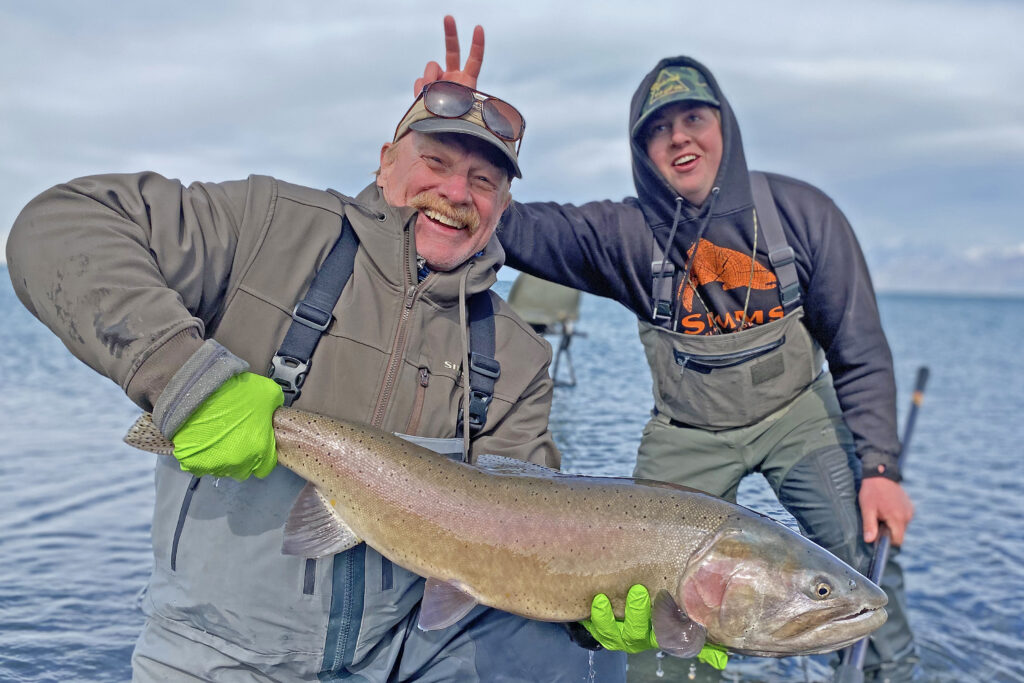
What are some of the fish species you tie flies for?
I cringe when I hear this question. As a tying instructor, demonstrator, presenter and fly designer I feel anglers compartmentalize flies the wrong way. A fly cannot actually target a specific species of fish, the angler does that. The fly can only mimic a food source and may be useful in many different situations for many different species. I tie flies for all types of food sources and fishing situations. I’ve flyfished for rainbow, cutthroat, brown, brook, cut-bow and tiger trout. Pacific and Atlantic salmon, grayling, American shad, largemouth and smallmouth bass, many species of panfish, carp, pike, red drum (redfish), weakfish (speckled trout), jacks, barracuda, sharks and bonefish. I think my favorite species are steelhead, snook, tarpon and permit.
What was your first fishing experience/When did you begin fly fishing?
I can’t remember what my first fishing experience was. Some of my oldest memories are fishing for bluegill with bait and bobbers with my Dad probably before I was 5. I fly fished only a few times as a kid when he let me use his Granger Victory (which I now have) to fish for panfish in grade school. I flyfished a bit more in high school and college for bass and panfish, but was still primarily a gear and bait fisher. After I took my first fly tying class I bought a better fly rod (upgrading to a 4 wt graphite rod from my 8 wt fiberglass Wonderod) then began building my own fly rods. Over the next several years I gradually converted to almost exclusively fly fishing.
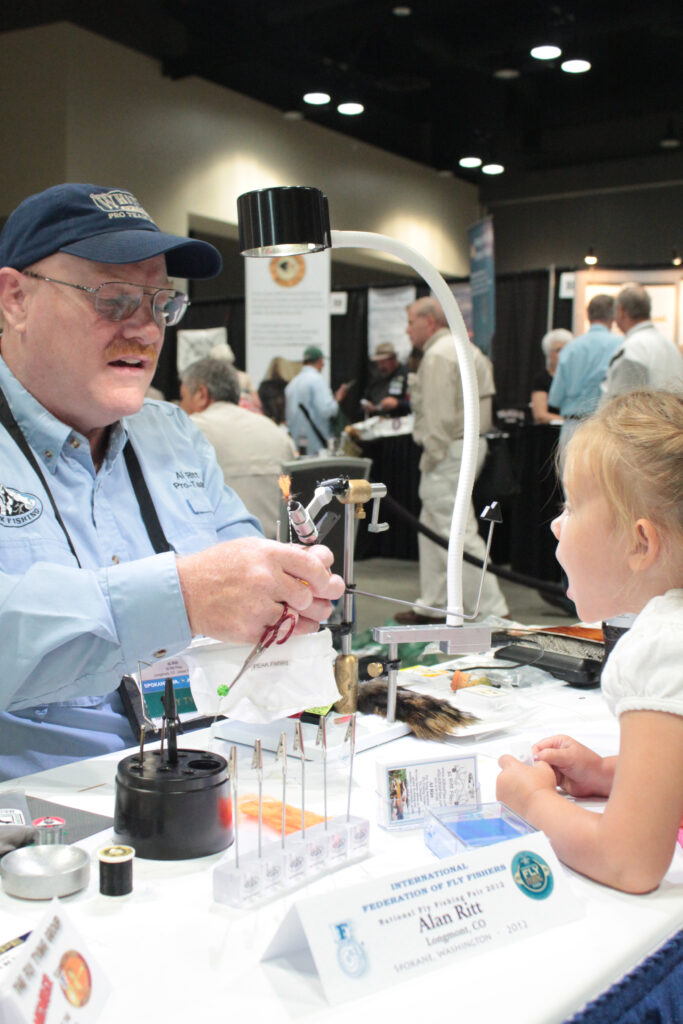
What is currently on your vise?
Currently on my vise are a series of flies for my next presentation followed by flies for demonstrations at a multi-day expo. So I will be tying a couple samples of 6 flies to accompany a friends presentation on carp fishing followed by several different patterns I will demonstrate at the expo. The exact patterns are Rickard’s Simi-Seal Leech, ARF Bunny Shrimp (a pattern I use primarily for bonefish and permit but configured specifically for carp situations), Barry’s Carp Fly, ARF SlimFlash Damsel, Ritt’s Fighting Crayfish, Usual, Kamikaze Sculpin, Quill Gordon Paraloop (a traditional Quill Gordon modified to use a hackle stacker style hackle), ARF Devil’s Doorman and a Paraloop PMD (a PMD colored bug tied as a cripple with Bob Quigley’s paraloop style hackle on a Klinkhammer hook)
Tell us about any flies that you’ve designed yourself.
The first fly I designed was many years ago and I named it Ritt’s Fighting Crayfish. My goal was a crayfish pattern with a frightened crayfish attitude in the water that could be fished relatively snag-free along the bottom. To achieve a relatively snag free design I utilize a hook-up design. The claws-up posture comes from using a bent shank hook, weight at the back of the fly and claws on flexible arms that float. I incorporate a lot of elements into the fly (loose dubbing, hackle, flexible arms, eyes and antennae) to allow the fly to move during it’s retrieve and at rest.
Montana Fly Company has carried this pattern in multiple sizes and colors for about 15 years now and commercially it’s been my most successful fly. After that fly I quit putting my name on patterns. In doing some research I discovered that there are many patterns available claimed (both accidentally and intentionally by multiple tiers) so after that first pattern I was hesitant to “stake claim” to a pattern by naming it with my name. But because the fly names I was using often seemed very generic I began adding ARF (Al Ritt Flies) to the names. That felt “less possessive” while still allowing for some differentiation for how the fly might be unique.
Other patterns I tie (quite a few are or have been commercially produced by Montana Fly Company) are ARF SlimFlash Damsel, ARF Articulated Migrating Damsel, ARF Articulated Sculpin, ARF Bird Fur Shrimp, ARF Bunny Shrimp (my favorite saltwater pattern, but adaptable to may freshwater situations as well), ARF Devil’s Doorman, ARF Egg Sucking Gnat, ARF Electric Zonker, ARF Fool’s Coal Stone, ARF Fool’s Gold Stone, ARF Gen-X Soft Hackle (done in several different color combos), ARF Harey Drake, ARF Harey Dun, ARF Hi-Vis Damsel, ARF Humpulator, ARF Life&Death Callibaetis, ARF Mara-Truder, ARF Midge Adult, ARF Midge Pupa (modified to also be used as larva and emerger patterns), ARF Mirror Mysis, ARF Muppet, ARF Simple Stone, ARF Spawning Ghost, ARF Struggling Green Drake, ARF Swimming Baetis, ARF Harey Caddis, ARF Harey Stone and ARF Tung-Syn PT (accounts for the majority of fish I catch in freshwater situations). I have a few other patterns, but they are not patterns I tie and use frequently.
What is it that draws you to fly fishing and fly tying?
Another question that is difficult to answer. I’ve always been fascinated by fishing and tying, as far back as I can remember. I enjoy the environments, studying the behavior of fish and their food. I enjoy fly casting. I enjoy just being near water.
Who is your biggest inspiration/mentor?
There is no way I could answer this question, there are just too many tiers who I respect and have learned from. Obviously, Len Beardon, owner of The Millpond had a great influence as I really got my introduction through Len. And he was a great fly tier as well. I spent the most time with Dale Darling, owner of St Vrain Angler in Longmont, Colorado. Dale is one of the best fly tiers I have ever watched and I tied with him and took classes from him (often the same class repeatedly) over and over.
Scott Sanchez is one of the most “out-of-the-box” thinkers I have been around and has influenced me to think about flies and fly design in unconventional ways. As far as technical tying skills and teaching, Wayne Luallen, Steven Fernandez and Charlie Craven are three of the most technically proficient tiers I’ve watched (and fortunately for me I know all three) and all three are wonderful teachers. To list everyone I watched and learned from would take far too long and too much space.
What is your favorite book about fly tying? Why?
I would never even try to limit it to one. I have a bookcase of fly tying references that I read for the enjoyment of the stories, the history of tying and the technical content. Depending on my intention for picking up a book, that answer would change each time.
What are some favorite fly tying resources that you direct others to?
Fly Fishers International (FFI) has a Fly Tying Group guided by a board of directors that is dedicated to promoting and teaching fly tying. That organization has many resources available to tiers. I typically refer my students to Charlie Craven’s beginning fly tying book, it has excellent instruction and photos on a wide range of techniques. I caution my students about YouTube videos, there are great ones available and others that I would categorize as “less helpful.”
If I were to recommend specific “YouTubers” I would say Charlie Craven and Fly Fish Foods. Also the FFI Fly Tying Group has a library of thousands of videos that have been viewed by members and vetted as good information. I try not to sound too much like a self promoter, but I believe my book – 25 Best Most Versatile Flies – has very good written instruction and photos. It actually has 87 patterns with almost 1300 step-by-step photos, Each of the 25 chapters is based on one fly, but talks about how the fly was developed and how it has been adapted or modified for more fishing situations. The goal is to provide tying instruction that is technique based and provide information to inspire tiers to expand their horizons by thinking about alternate ways to combine techniques and materials to come up with more effective flies and how to use them in various situations.
What was the first fly pattern you tied?
There was no pattern for my first fly. My Grandmother helped me with it and she did not fish so she did not know the recipes or names of patterns. She simply reproduced what the shop owner showed her. I wish I remembered the patterns from my first class, they were quite different that what is typically taught today, it was a very technique oriented class whereas todays classes usually focus on how to tie a specific set of patterns, not how to tie flies in general. Some of the flies I do remember being part of that into class were an AP Nymph, a Hare’s Ear, an Adams, an Irresistible and a Humpy.
Is there a fly style that you are still interested in learning about?
I’ll dive into most anything. Some styles I don’t find as interesting for me and I drift away from them, others I find myself fascinated and I tie lots and use the techniques in many aspects of my tying. I love spey flies. I have less interest in Mop flies.
What advice would you give to someone thinking about beginning fly tying?
Buy good quality tools, don’t try to get by with poor tools and risk being so frustrated you give up. Good quality tools will also last a lifetime. Buying poor tools simply guarantees you’ll have to buy them twice as the poor ones won’t hold up. Then, concentrate on learning techniques and properties of materials. If you understand techniques and materials you’ll be able to look at almost any fly and figure out how to tie it, modify it for you purpose or preferences or come up with your own patterns.
What’s the first fly you typically recommend a beginner to learn to tie?
My first class session we review tools and materials then go over mounting the hook in a vise, adjusting bobbin holder tension, starting thread on a hook and the whip finish. It’s not until the second session (after practicing those first few steps) that I introduce a pattern, typically a Woolly Bugger. Besides being wonderfully effective, the Woolly Bugger offers opportunities to learn attaching various materials using different techniques, wrapping materials, thread manipulation and tying off various materials.
Favorite and least favorite thing about tying flies?
I enjoy teaching fly tying. That’s my favorite aspect. What frustrates me the most is seeing new tiers go down a narrow road that focuses so much on specific patterns that they don’t learn fundamental techniques, how to apply those techniques and material properties and uses.
What fly tying technique took you the longest to learn?
I’m honestly not certain.

Let’s talk about fly tying equipment and materials:
o Tell us about your scissors. Do you use a generic brand or specific style, and why?
I use Thompson Ice scissors, which are unfortunately no longer available. They are very sharp and retain their edge very well. The open loops allow me to adjust the openings to fit my fingers comfortably. This is import for me because of the way I hold and handle my scissors (I never put mine down, I simply roll them behind my hand. That way they are always readily available, I never have to look for them and they don’t get lost in any clutter on my tying bench). I strongly recommend each tier handle some different scissors and find a style that is comfortable for them and fits the way they tie.
o What about bobbins: tension or no tension?
I use just enough tension that the spool weight will not cause your thread to unwind if you let the bobbin holder hang. By squeezing the arms of the bobbin holder I can vary extension as needed.
o Your tying vise is practically sacred. What is your go-to, and why? How many did you try before deciding this was your favorite?
I’ve tied on several over the years, most with great success. Dyna-King, Renzetti, PEAK, Nor-Vise and Thompson. What they all have in common, and what is critical, is that they all hold hooks well and they all stay in place on your table as you tie. That may sound silly, but not all vises accomplish those two things and those are the two primary functions a vise absolutely must accomplish. Beyond that it’s primarily ergonomics and I recommend students try different vise to see what is comfortable prior to buying. I currently tie on a Dyne-King Barracuda Deluxe
o Where do you source your fly-tying supplies? Why do you choose these resources over others? (okay to mention more than one resource)
My preference is my local fly shop, that way I can actually see what I’m buying. It’s less critical with synthetic materials as they tend to be more consistent, but it can be critical for achieving you desired result with natural materials. And if it’s a new material I haven’t used I can evaluate it’s properties to see if it seems appropriate for what I’m trying to accomplish
o Do you have a particular type of hackle that you prefer over others?
Whiting Farms. It’s incredibly high quality and very consistent.
o Do you prefer synthetic or natural materials when you use it? (dubbing, hackle, bucktail, etc.)
I prefer natural materials in general, probably because that’s what I learned with and I generally like “old stuff.” However, they top concern is which is going to give me the effect I want on the fly.
o What brand of hooks do you prefer to tie on?
We are very fortunate that in this day and age there are several very good hook manufacturers. That was not so much the case when I began I currently use Daiichi hooks but have had good results with, and sometime use, TMC, Partridge and Gamakatsu
o What is your preference in head cement and resin?
I prefer to avoid head cement as it can clog hook eyes and/or seep into materials and change their color/texture if improperly prepared. When I do use cement it’s Hard as Hull (which I’m pretty certain is Sally Hanson’s clear nail polish). I am using UV Craft when I use resin.
o Let’s talk about thread… How should a tier approach choosing the right thread for their fly?
First, get an understanding of different threads and their properties. Do you want ultimate strength with reduced size (GSP), do you need a finer thread (GSP or smaller denier measurement), do you need to flatten or split your thread (use a thread that is not bonded like Uni-Thread and is not as heavily waxed), do you need a strong thread that will also add volume to the fly (use a heavier denier). I recommend finding a brand and sticking with it until you better understand the properties of different threads. Typically 70 denier thread (UTC, Danville and Veevus are three good ones) will do most anything the majority of fly tiers need to do.
o What’s the one fly tying material you can’t live without? What’s so special about it?
There really isn’t one material. Each material has it’s own uses and it’s difficult to come up with a material that has no replacement. Perhaps the closest thing might be dry fly hackle, but there are alternative techniques utilizing alternate materials to replace even that.
Do you tie for personal use, or do you sell your flies?
I tie primarily for myself and as a teaching activity (classes, presentations, demonstrations). I do tie a few orders for people who request something specific, but I don’t try to make a living at it.
What is your favorite fly pattern to tie? What is the intended species for the fly?
This changes a bit related to my mood, but day in and day out the answer is probably an Adams more frequently than any other pattern. The Adams was designed to match a now unknown hatch on a trout pond in northern Michigan. But as we’ve touched on, in my mind, it should not be considered species specific. it imitates a bug of some kind on the water and there is absolutely no doubt in my mind it will catch panfish, bass, grayling, trout, salmon, steelhead, carp and in all likelihood other species as well. I have caught several of these species on an Adams.
Where can people find your work? (Retail store, online store, social media handles, etc)
I teach classes at Montrose Anglers Fly Shop in Montrose Colorado, I run a monthly fly club at Ed’s Fly Shop in Montrose Colorado, I teach individual and group classes/lessons at private residences and various venues. I demonstrate and present for clubs across the US and have done demonstrations/presentations for shows and expos throughout the US and Canada. My patterns are produced commercially by Montana Fly Company and can be found at MFC dealers. My book may be available through fly shops, book stores and Amazon. My flies and books are also available directly through Al Ritt Flies by contacting me at al@alrittflies.com
Any parting thoughts you’d like us to add?
Fly tying is a fun and exciting craft/hobby/artform, depending on your situation. Enjoy it for all it can be.
